Lujar is a small, traditional country village nestling in the foothills of the Sierra Nevada and yet only fifteen minutes’ drive from the beach. It’s surrounded by almond trees, olive groves and ancient cobbled mule tracks that weave their way through the valley.
|
|
Lujar is a small, traditional country village nestling in the foothills of the Sierra Nevada and yet only fifteen minutes’ drive from the beach. It’s surrounded by almond trees, olive groves and ancient cobbled mule tracks that weave their way through the valley.
|
|
|
|
|
| On a clear day, you can see Morocco from our terraces and you can still spot many Arabic influences around the village. |
|
|
|
 |
Lujar became important as it was on the trade route from the coast to Granada and the ancient mule path that they used still exists today. |
|
|
|
| Lujar is no longer wealthy but It’s a working village and you'll see goats and mules walking daily through the village to and from the fields and most houses still have a stable below their living quarters and a chicken shed. |
|
|
|
|
|
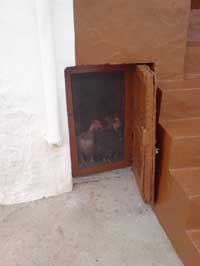
|
Who knows how long the village will remain so unspoilt. The old men in slippers, cardigans and the obligatory blue work trousers who hold on to their mules in one hand and their mobiles in their other, will gradually die off, taking this way of life with them.
|
|
|
|
There is a fantastic communal swimming pool, football pitch, and tennis and basketball courts a few minutes walk from the house. 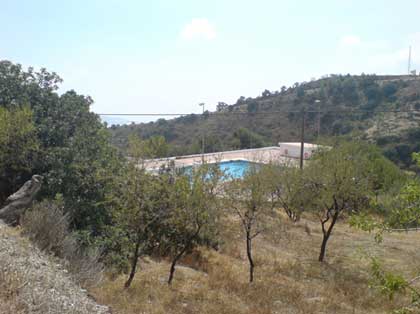
|
|
|
|
There's a village school with 13 children and a Doctors surgery, a library and a town hall.
The Doctors surgery is visited twice a week by a Doctor from neighbouring Castell where there is a 24hr Medical Centre. The Doctor will also visit the village during the night if you are really sick. For UK residents this is all covered by your E1-11 medical cards.
|
|
|
|
|
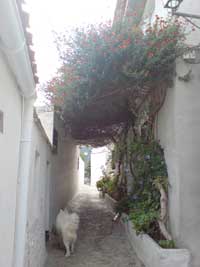 |
There are only 2 bars and no shops other than a chemist open 2 mornings per week.
(Although during summer months there is a tobacconists kiosk selling drinks, sweets, snacks etc.)
|
|
|
|
| There are daily visits from vans selling bread and cakes, meat, ice cream, fish, fruit and veg. They come at specific set times and honk their horns to signal their arrival. You simply join the queue of women and start practising your Spanish! (Actually the bread man speaks perfect English). |
|
|
|
|
You can fill up water bottles for drinking at the spring in the centre of the village and you'll be invited to pluck lemons or pomegranates from the village trees and be given almonds and olives at other times. There are plenty of shops in the fishing village at the bottom of the hill and huge supermarkets in Motril.
|
|
|
|
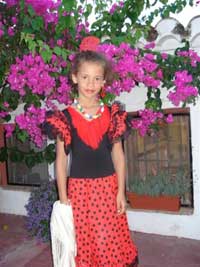 |
In the summer, the village is full of children who come to stay with grandparents over their holidays. The village square is their meeting place and they play football each evening at the pitch and often, during the late afternoons, perform traditional Spanish dances around the swimming pool, accompanied by bongo playing. You may find them inviting younger children for rides on their pet donkeys – they are very warm and friendly and rarely pass without saying “hola!”
|
|
|
|
| You need to watch what you wear in the village, you certainly don't need to dress up but it is offensive to the villagers to walk through in a bikini or very skimpy clothing although of course, fine at the pool! If you want to go topless, you need to save it for the beach or terraces, It’s frowned on at the pool. |
|
|
|
|
|
THE BEACH & Castell
Castell De Ferro is the name of the small fishing village at the bottom of the mountain with a shingle beach. It’s a fifteen minute drive away. There are supermarkets, shops, petrol stations, bars and restaurants with markets on the beach at the weekends. Although there are new Urbanisations being built, it is basically where Spanish families come on holiday in the summer. There are no real water-sports there.
|
|
|
|
|

|
|
Up and down the coast there are numerous coves and beaches, some have sandy bits but most are shingle. Big water sports beaches are a further 15 mins drive down the coast and there is a massive water park 40 minutes away in Almunecar. |
|
|
|
| Separating Lujar from the coast is a stretch of farmland that extends for miles, bordering the E15 road that runs along the Costa Tropical. This is an agricultural region which means that there are far fewer tourists and fewer urbanisations but it does mean that you see acres and acres of plastic covered plots which ‘greenhouse’ the crops and dry cement based river beds – essential as in the past the river banks have burst during the winters. These are not very attractive but are left behind you as soon as you head up the mountain or go beyond them to the beaches |
|
|
|
|
|
WHAT TO DO
|
|
|
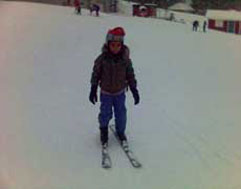 |
|
In January and February you can ski in the morning and be on the beach sunbathing in the late afternoon. It is usually warm enough to lie on the terraces in the winter and we have spent Christmas’s in bikinis but it gets cold at night and the sea is freezing. |
|
|
|
| Winter is the perfect time to visit the Alhambra or pop over to Morocco on the ferry. The deer come down from the mountains at this time and often walk into the gardens of houses at the top of the village. |
|
|
|
|
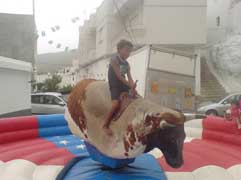 |
|
There are numerous fiestas scattered throughout the year in Lujar and It’s surrounding villages. The August bank holiday sees Lujar’s biggest with amazing fireworks, village games, bucking bronco, bands and a huge 12 foot wide dish of paella! |
|
|
|
|
During the summer, the pool is perfect, the sea is warm and the village gets a mountain breeze so is several degrees cooler than the beach.
|
|
|
|
|
|
| The beautiful historic white pueblo villages of the Alpajurras are all within easy driving distance and the area immediately surrounding the village is perfect for walkers, bird watchers and cyclists. There is a good market on Saturday mornings at Almunecar, 40 minutes drive away and a slightly smaller one on Tuesdays and Fridays in Motril. |
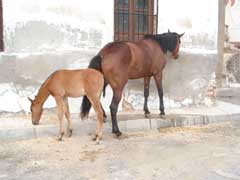 |
|
As well as the football, tennis, swimming and basketball in the village, there are Golf courses close-by – a good one is in Motril.
If you want to go horse riding , you can hire horses via Maria in the village bar who sets it up with Sebastian who has a ranch on the edge of the village.
|
He or one of his cowboys will accompany you or you can head off alone.
There are also various mountain bike centres and other bigger stables near by. There are numerous walks and cycling routes you'll find maps at the main house – please leave these behind you when you leave. There is a massive nature reserve just outside the village.
Be careful in the winter as the clouds can come in quickly and you can be stuck out on the hills.
There is an English alternative therapist, Pauline, living behind us who offers treatments– reiki, reflexology and massage. There are also nearby yoga retreats in the pueblos of the Alpajurras that have a fantastic reputation.
Aqua Tropical water park, Almunecar on the Costa Tropical in Spain:
Open mid July to mid September. Entertainment for all ages; there is a selection of bars and restaurants as well as some shaded spots to relax with a book.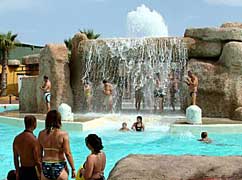
Nejar Caves
|
|
|
|
BARS & RESTAURANTS
If you are looking for clubs, you'll have to drive into Motril but even there, there won’t be many tourists. There are some discos scattered along the coast. |
|
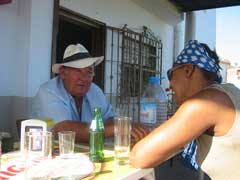 |
| There are ‘English Bars’, often showing Sky Sports in Torreneuvo and some lovely restaurants in Salobrena, which also has a dramatic castle. There are dozens of bars and restaurants on the beaches in all of the coastal villages. Most of these speak English. |
|
|
|
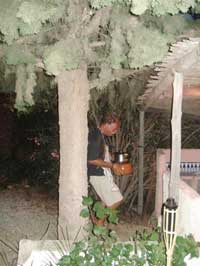 |
|
Lola’s bar at the pool in Lujar serves food and drink and has a good basic lunch menu. Maria’s Bar at the other end of the village offers a fantastic traditional local food spread cooked by Maria and her Mum but you'll need to book the day before, as they buy in all the produce fresh. |
At the bottom of our hill on the rambla is the Cortijo Torrera and, by arrangement, you can have the best bbq ever – the bar is open there serving delicious tapas every evening in the summer and the owners, Leon and Ana speak English. Good music too! |
|
|
|
FESTIVALS
|
|
|
3rd May. Santa Cruz Festival
A religious festival when neighbours make a promise to Santo Christ de Cabrilla and invite each other to share doughnuts and chocolates in celebration of this holiday of coexistence
3 de Mayo, Fiesta de la Santa Cruz
Fiesta religiosa, donde los vecinos con promesa al Santo Cristo de Cabrilla invitan a buñuelos y chocolate a todos los que decidan compartir esta día de fiesta y de convivencia.
|
June, Celebrations in Honour of the Virgin of Fátima:
Celebrated in the district of 'Los Carlos' the last weekend of June.
Junio, Fiestas en Honor de la Virgen de Fátima:
Se celebran en la pedanía de Los Carlos el último fin de semana de junio.
|
August, Celebrations in Honour of Santo Christ de Cabrilla:
Days of celebration to enjoy music and the joys of each other. The official festival date is the 14th September, but the celebrations usually start the end of August.
Agosto, Fiestas en Honor del Santo Cristo de Cabrilla:
Días para disfrutar con nosotros de la fiesta, la música y la alegría. La festividad es el 14 de septiembre, aunque la celebración se adelanta al mes de agosto.
This is the main fiesta in Lujar. It begins on Friday – usually the last one in August- with a religious procession. Saturday and Sunday begin with a traditional Spanish band who process around the village and may stop outside your door or window. Then there will be childrens village games, bucking broncos, huge water fights and various races. Both days will provide a huge meal in the village square – paella on one day and usually pork and goat on the other. There are cooking competitions and the crowning of the Lujar beauty king and queen. The boys play a football match late at night. The evenings last long into the night with live music and a mix of flamenco and europop! There will be an enormous display of fireworks by the church around midnight both nights. A programme will be available from the town hall or from either bar which will detail the many things going on over the weekend. It’s all free although you may be asked for a donation (approx. 20 Euros per house is acceptable) and you may have to pay for drinks tickets in the evenings.
|
7th October, Celebrations in Honour of Our Lady of the Rosary.
At nightfall, everyone in the village gathers at the path that leads to the town hall. At the front of the procession, young men from the village hold up a huge, heavy figure of the Virgin Mary on a throne. They are followed by the women of the village, eldest first. All the women hold a red candle. The men follow with children and tourists at the back. The procession winds up and down all the mule paths of the village. Most homes have the lights on and their doors and shutters open. It’s a great chance to look into all the houses you never see! On the main lane, you'll see the inner patios and indoor gardens that lead up to the main salons in traditional Lujar homes. The procession ends on the steps in front of the church. This candle lit evening is a beautiful way to explore the village. Participants should dress quite smartly, as if for church.
|
6th Jan., The Three Kings Festival
The day that children in Spain look forward to. They leave their shoes outside the front door overnight and in the morning the kings will have filled them with sweets or toys! Lujar does not generally provide a festival but Castell De Ferro does. Children gather outside the church by the piazza and the three kings arrive on a truck throwing sweets out of the back of a lorry. They then sit on thrones and the children queue up several times to receive a gift. Motril has a huge festival for three kings day – the biggest in the province, attracting 40,000 people. The 3 Kings generally arrive by boat and process up to the main church. All the bars offer great tapas late into the night. |
|
|
|
WEATHER
|
|
|
|
|
|
|
|